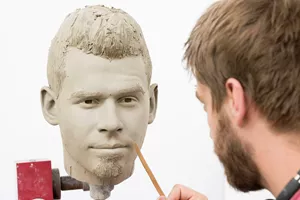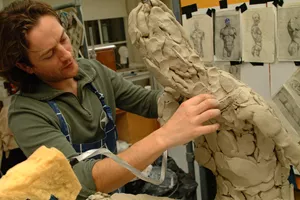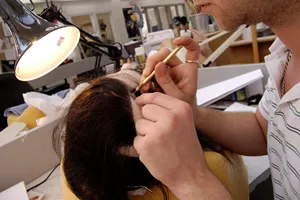Behind the scenes

How are our wax figures made?
The way wax figures are made today has hardly changed from how Madame Tussaud's herself made them in 1790.
Pose session
After determining who qualifies for a wax likeness, the creation of a wax figure takes an average of nine months. Various specialists and craftsmen are involved in this process. In almost all cases, the person concerned poses, during which the sculptor takes all measurements from head to toe. A photographer takes pictures from every conceivable angle. These photos are not only used by the sculptor when making the clay figure, but also at a later stage when colouring and cropping the sculpture. The colour specialists look at the colour of the skin, eyes, teeth and, in the case of women, the make-up used. A hairdresser is also present who uses samples to determine the right colour of the hair and eyebrows and, after the person's consent, cuts off a piece of hair.
Clay figure
Simultaneously with the clay figure (as a sculpture is first completely modelled in clay), eyes and teeth are recreated as exactly as possible. The colour of the eyes is carefully selected with the help of a chart containing all kinds of colour combinations. A plaster cast is made of the teeth, usually done by the sculpted person's dentist.

Mould
After the sculptor is finished with the clay model, a professional moulding engineer makes a plaster mould of the head and hands. Hot wax is poured into this mould. When the wax has cooled, the plaster is carefully peeled off and the head is ready to be coloured.
The hair
A team of experts colours the wax head and hands (these are often the only parts made of wax). Reproducing the hairstyle is a very detailed and meticulous job.
Real hair is used and literally implanted hair by hair on the head! When the hair is ready, it is washed, cut and blow-dried.
The body
A plaster mould is also made of the clay body. This mould is filled with fibreglass. This is because the body of a sculpture is made of fibreglass. If it were made entirely of wax, it would be too heavy and sag. The sculpture is then ready to be dressed. The person portrayed usually donates clothes to his or her statue.

London-Amsterdam
After the wax sculpture has been inspected for the last time, it is prepared for shipment from London to Amsterdam. The statue is transported from Tussauds Studios by car and by ferry with a special driver. Before the statue is then placed in the attraction, hair is still styled and clothes are neatly prepared. The cost of a statue is about €250,000.
Maintenance
Madame Tussauds Amsterdam has a department called 'Studio Amsterdam' where the statues are maintained. Studio Amsterdam conducts an inspection round in the morning before visitor time and checks all the statues. Statues in need of maintenance are addressed immediately. At Madame Tussauds Amsterdam, visitors are allowed to touch the statues and admire them up close. It regularly happens that someone damages the face slightly with his or her ring or pulls loose hair. All repairs are done by Studio Amsterdam, for example: scratches, loose hairs, discolouration of the 'skin' and so on.
In Amsterdam, images are taken out of the show regularly anyway to give them a maintenance service. As a result, some images may not be present, despite being shown on the website.
During maintenance, all layers of paint are removed with turpentine and the eyelids and lips are rebuilt. This is because the turpentine causes the wax to soften and break down. After this is done, the statue is re-coloured layer by layer. Such maintenance also involves taking the clothes to the dry cleaners, washing the hair with shampoo and blow-drying it back into shape. Make-up is also touched up with oil paint. This is done in a special way, namely by splashing paint on the face and neck. This gives a very realistic effect, as normal skin is usually blotchy too.
Furthermore, glasses and other jewellery are invisibly but securely attached to the statue to prevent theft. Some statues are also additionally secured with an alarm system, so should people really want to move them, the alarm goes off.
Want to know more? Feel free to send us an email!

